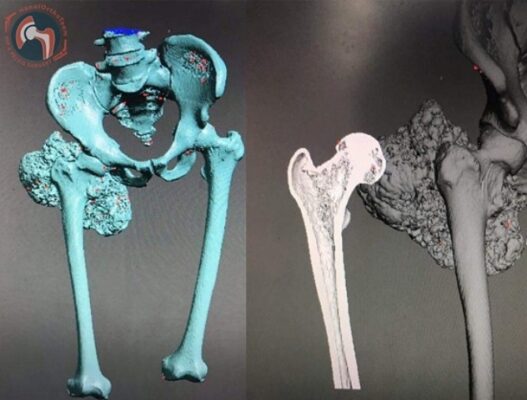In the context of bone cancer, musculoskeletal pathologies, sports injuries, occupational accidents… that pose a risk of disability, the development of artificial bone substitute surgery has contributed significantly to changing the lives of many patients.
Research on Artificial 3D Bone Material
Peek material was officially licensed by the Ministry of Health for use as a material in the field of healthcare in Vietnam in 2012. Previously repairing bone fragments in Vietnam often involved using the patient’s own bone and had to be stored at very strict temperatures.
Associate Professor, Dr. Ngo Duy Thin, from the Department of Embryology at Hanoi Medical University and Chairman of the Board of Directors of Bao Ngoc Healthcare Company, stated that in 2018, the People’s Committee of Hanoi assigned the biomedical materials Research and Development Institute – Ngoc Bao Biomedical Joint Stock Company the scientific and technological task of “Research and manufacture cranioplasty patch and torus mandibularis using 3D technology from PEEK materials.” Currently, the product has been implemented in many healthcare facilities.

|
Nghiên cứu vật liệu Peek thay thế xương. |
The 3D printing technology with Peek material has been applied to various products, such as cranioplasty patch, torus mandibularis , and oral & maxillofacial bone grafting.
The first cranioplasty patch using 3D technology from PEEK material, produced by the Biomedical Materials Research and Development Institute, have been clinically tested on more than 10 patients at Hai Duong General Hospital, who suffered from specific bone pathologies such as bone loss, bone fractures, double fractures, complex fractures, and extensive injuries.
Monitoring results clearly demonstrate the outstanding characteristics of this individually crafted product using PEEK material, not being inferior to products from countries in the region. Particularly, a cranioplasty patch from the Institute, which is designed with anti-collapse and anti-subsidence supports, eliminating the need for fixed braces and reducing costs for patients.
According to Associate Professor Dr. Thin, the use of implanting products made from PEEK is becoming increasingly popular in the fields of trauma, orthopedics, cranial shaping, and spinal surgery. “The world has been using this material since 1990, and Vietnam has been researching this material since 2002”.
Professor Dr. Thin asserts that the products resulting from the research by Vietnamese scientists are not inferior to those from countries in the region. Particularly, the cranioplasty patch designed by the research group includes anti-collapse and anti-sink supports, eliminating the need for fixed braces and reducing costs for patients.
Currently, this material is being applied in practice at three hospitals, including Hospital K, Xanh Pon General Hospital, and Medical University.
Opening a New Page in the Orthopedic Field
Associate Professor Dr. Tran Trung Dung, Deputy Director of Xanh Pon General Hospital in Hanoi, the institution receiving the research transfer from Professor Dr. Thin in the clinical practice, highly praises the PEEK material.
According to Dr. Dung, the field of orthopedic trauma has had more superior technology, supporting doctors in regenerating bone fractures for patients. This innovation involves the application of 3D printing technology.
In this process, bone injuries are scanned by CT scans, computer generated imagery, and then 3D-printed using plastic to replicate the original size. This plastic bone segment is then used to create a mold for the Peek material. Consequently, a bone graft is created using Peek material, precisely matching the size of the removed bone segment.
This technology has played a crucial role in producing artificial bone segments, joints, and surgical instruments with high precision, extensive customization capabilities, and close compatibility with each specific patient case.
The combination of Peek biomaterial and 3D printing technology supports doctors, after scanning bone injuries through CT scans and computer generated imagery, printing from plastic to replicate the original size. This plastic bone serves as a mold for the Peek material, enabling doctors to create bone crafts perfectly matching the size of the removed bone segment.
However, with this new PEEK material, patients with bone cancer now have the opportunity to regain mobility with the support of the material that helps regenerate about 70-80% mobility compared to the previous one. At Hospital K, patients who underwent surgery using this material have shown high effectiveness in self-mobility, walking without the need for crutches.
PEEK biomedical materials and 3D printing technology are opening up new prospects for orthopedic surgery in particular and bone and joint regeneration surgery in general. For patients, this technology can significantly improve their quality of life, protecting them from the permanent disability that might result from bone removal due to unfortunate diseases.


 Tiếng Việt
Tiếng Việt



